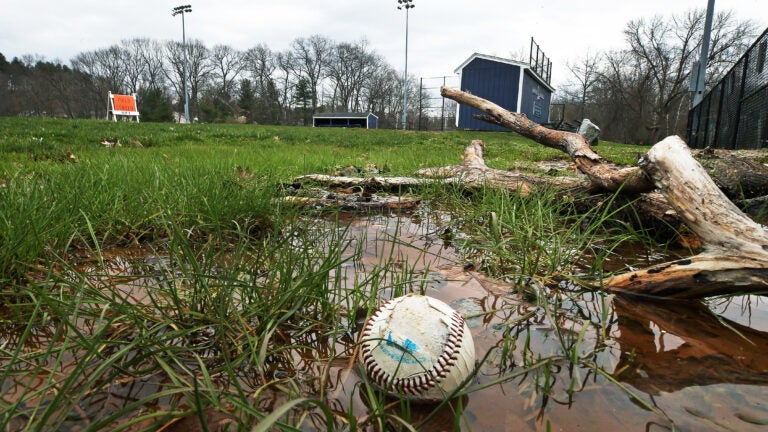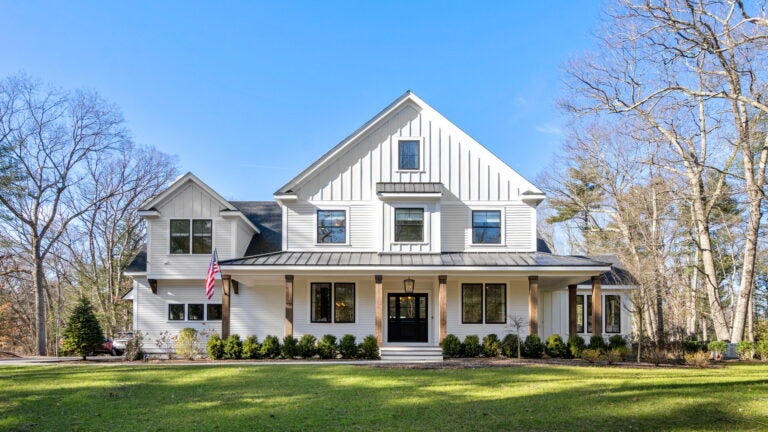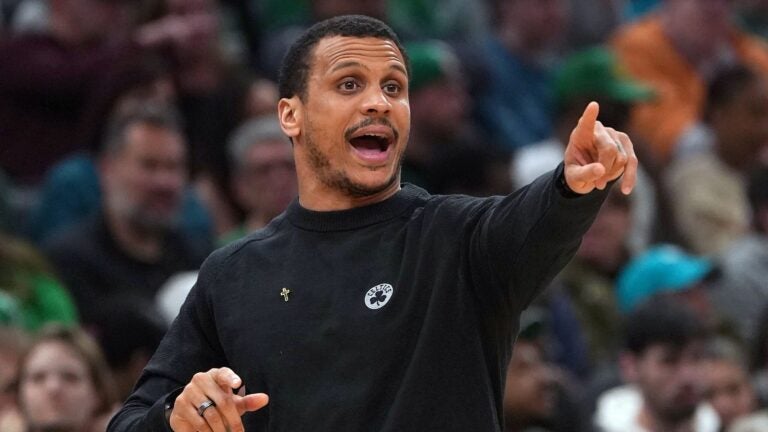Youth sports can begin to resume in Massachusetts during Phase 2 of the reopening plan. Here are the rules.
Games will only be allowed for sports that allow for social distancing.

For the first time since the beginning of the coronavirus outbreak, professional sports teams in Massachusetts were allowed to resume socially distanced practices this week.
Related Links
In the very near future, amateur athletes could follow.
Gov. Charlie Baker’s administration released standards for organized adult and youth sports to resume limited practices during Phase 2 of the state’s reopening plan.
“For both of my kids, their sports teams have been incredibly important to them and have been a big part of how they have grown as young individuals,” Lt. Gov. Karyn Polito said Wednesday. “I know how different time has been for many families that have children in sports.”
It will continue to be different during Phase 2.
The rules allow outdoor athletic fields, pools, and other facilities to open for everyone, while indoor fields, courts, and other enclosed facilities will only reopen for supervised youth sports and summer camps for people under the age of 18. According to guidance released earlier this week, indoor facilities won’t reopen for adult sports until Phase 3.
Locker rooms, weight rooms, fitness centers, and yoga studios will also remain closed. And during Phase 2, contact sports — like basketball, football, baseball, soccer, hockey, and lacrosse — are restricted to no-contact drills and workouts; games and scrimmages will remain prohibited. Organizers are also required to split participants into groups no bigger than 10, which must be spaced by at least 20 feet if they’re sharing the same field or court.
Games are only allowed for sports like tennis where regular play generally does not bring players into close contact.
Spectators are required — and coaches are encouraged — to wear face coverings, though athletes are allowed to remove them during drills. The rules also say facilities should try to limit nonessential visitors, including referees and officials, who the guidelines say are not required for practices and cannot be present.
Concession stands and shared team snacks also remain prohibited during Phase 2. So keep your orange slices to yourselves.
Baker said Wednesday that he will announce the beginning of Phase 2 this Saturday. Depending on whether the rate of positive COVID-19 tests and hospitalizations in the hard-hit state continue to decline, the phase could begin as soon as this coming Monday.
Here is the full list of rules for recreational sports when Phase 2 does begin:
LIMITATIONS ON RECREATIONAL ACTIVITIES AND FACILITIES DURING PHASE II
Outdoor Sports and Athletic Facilities
Organizations, businesses, schools and government entities that operate outdoor sports facilities, such as athletic fields, courts and other playing surfaces, outdoor pools, and sailing and boating facilities will be permitted to reopen their premises and facilities to adult sports and supervised youth sport leagues, summer sports camps, and other athletic activities provided that the safety measures outlined below are implemented by facility operators and activity organizers.
Indoor Sports and Athletic Facilities
Organizations, businesses, schools, and government entities that operate indoor sports facilities will be permitted to reopen their indoor facilities ONLY to supervised youth sports leagues and summer sports camps for participants under 18 years old. Indoor facilities may be opened to supervised youth programs provided the safety measures outlined below are implemented by facility operators and activity organizers. Such facilities include:
- Gymnastics Facilities
- Indoor Pools
- Indoor Athletic Fields and Courts
- Indoor Ice Rinks
- Indoor Tracks
- Indoor Gymnasiums
- Martial Arts & Dance Facilities (provided such facilities have sufficient square footage for social distancing)
- Indoor Racquet Courts
- Indoor Batting Cage Facilities
Locker rooms associated with indoor athletic facilities will not be allowed to open, but bathrooms may open.
Fitness centers and gyms, yoga studios, barre studios, spin studios, rock gyms, and other general fitness studios may not open in Phase II.
Indoor athletic facilities may NOT be used for adult athletic activities or for unsupervised youth activities during Phase II.
IMPLEMENTING SAFETY MEASURES FOR YOUR OPERATION
All business and other organizations in the Commonwealth must immediately adopt and maintain the following generally applicable COVID-19 safety rules.
Social Distancing
- All persons, including employees, customers, and vendors should remain at least six feet apart to the greatest extent possible, both inside and outside workplaces
- Establish protocols to ensure that employees can practice adequate social distancing
- Provide signage for safe social distancing
- Require face coverings or masks for all employees and customers
Hygiene Protocols
- Provide hand-washing capabilities throughout the workplace
- Ensure frequent hand washing by employees and adequate supplies to do so
- Provide regular sanitization of high touch areas, such as workstations, equipment, screens, doorknobs, restrooms throughout work site
Staffing and Operations
- Provide training for employees regarding the social distancing and hygiene protocols
- Employees who are displaying COVID-19-like symptoms do not report to work
- Establish a plan for employees getting ill from COVID-19 at work, and a return-to-work plan
Cleaning and Disinfecting
- Establish and maintain cleaning protocols specific to the business
- When an active employee is diagnosed with COVID-19, cleaning and disinfecting
must be performed - Disinfection of all common surfaces must take place at intervals appropriate to said workplace
The application of these measures for athletic activities for Phase II is detailed below:
Social Distancing
Facility Operator Guidance
- Indoor facilities may be used only by supervised youth sports and summer sports camps for participants under 18. Use of indoor facilities for adult activities or for unsupervised youth sports or activities is not permitted.
- Programs must separate participants into groups of no more than 10, including coaches and staff. Larger playing areas and surfaces, such as athletic fields, tracks, tennis courts, and fullsize basketball courts, may be used by more than one group of 10 at one time, provided that adequate social distance and group separation can be maintained. To ensure group separation, groups must be spaced at least 20 feet apart while sharing a playing surface or field.
- Scrimmages, organized games and tournaments are not allowed for contact sports in Phase II and activities must be limited to no-contact drills and training exercises. Contact sports are those where ordinary play puts players into contact or close proximity to one another, and include, without limitation, basketball, football, baseball, soccer, field hockey, lacrosse, and hockey.
- Games are permitted during Phase II only for no contact sports where ordinary play allows for social distancing (e.g., tennis and other racquet sports), but inter-team games or tournaments are not allowed.
- Locker rooms, weight rooms, and indoor common areas must remain closed.
- Limit any nonessential visitors, spectators, staff, volunteers, and activities involving external groups or organizations as much as possible. Visitors, spectators, volunteers and staff must wear face coverings. Operators are encouraged to mark off spectator/chaperone viewing sites to allow for social distancing.
- Spectators/chaperones must practice social distancing including wearing face coverings.
- Indoor facilities shall institute one-way entrance and exits while adhering to established fire and building codes.
- Indoor batting cage facilities shall ensure adequate social distancing between each cage, such as limiting use to every other cage. Indoor batting cages are only for supervised youth sports and summer sports camps.
- Access to equipment storage and office space should be limited to employees only. First aid kits should be available at the playing area or court rather than in an office, where possible.
- Facility managers must set, post, and monitor occupancy limits for bathrooms based on the ability to maintain six-foot social distancing.
Activity Organizer Guidance
- Youth sports summer camps must follow all applicable summer camps guidance.
- Limited sports activity is allowed for players; players must maintain 6 feet of distance at all times and there should be no contact between players. If maintaining physical distance is difficult or impossible because of the nature of the sport, coaches should limit players to workouts, aerobic conditioning, individual skill work, and drills.
- Scrimmages, organized games and tournaments are not allowed for contact sports in Phase II.
- Contact sports are those where ordinary play puts players into contact or close proximity to one another, and include, without limitation basketball, football, baseball, soccer, field hockey, lacrosse, and hockey. Games are permitted during Phase II only for those sports where ordinary play allows for social distancing (e.g., tennis and other racquet sports).
- Referees, umpires and other officials are not required for practices and cannot be present in Phase II.
- Participants and coaches/instructors/counselors must be kept in the same small group (cohorts) with dedicated coaches or other staff.
- Spectators must be limited to ensure social distancing on the sidelines or other observation areas. Spectators of youth sports and youth summer sports camp should be limited to one adult chaperone per athlete. If social distancing is not possible in the athletic facility spectators may be asked to wait outside the facility until practice is completed. All spectators must wear face coverings.
- Coaches must be responsible for maintaining social distance among players, coaches, staff, and spectators. Youth chaperones should be encouraged to help their own child maintain distance before and after practice. Youth chaperones must wear face coverings.
- Athletes should be discouraged from high fives, fist bumps or other social contact during practice.
- Hygiene Protocols
Facility Operator Guidance
- If any equipment is provided by the operator, operators must minimize equipment sharing, and clean and disinfect shared equipment at the end of a practice session using a product from the list of disinfectants meeting EPA criteria for use against the novel coronavirus.
- Indoor facilities must provide access to handwashing facilities on site, including soap and running water, and allow sufficient break time for staff and participants to wash hands to frequently; alcohol-based hand sanitizers with at least 60% alcohol may be used as an alternative.
- All facilities must supply employees with adequate cleaning products (e.g., sanitizer, disinfecting wipes).
- Operators must post visible signage throughout the site to remind employees and visitors of hygiene and safety protocols.
- Locker rooms, indoor showers, saunas, hot-tubs and steam rooms must remain closed.
- Operators must close any public water bubblers, fountains or bottle fillers if present on site
Activity Organizer Guidance
- Organizers must ensure that participants use their own personal equipment if not provided by the organizer or facility operator. Personal equipment may not be shared and must be dedicated to an individual player throughout the season. Personal equipment includes all gear that is worn by players (e.g., gloves, helmets, masks, skates, footwear, pads, etc.).
- Organizers should minimize sharing of other equipment, and clean and disinfect all equipment at the end of a practice session using a product from the list of disinfectants meeting EPA criteria for use against the novel coronavirus.
- No shared food or drink may be provided during any activities for participants or spectators (e.g., concession stands or team snacks). No use of public water bubblers, fountains or bottle fillers if present on site. Participants and spectators should only drink from their own containers. Organizers must provide individual, dedicated water bottles for children if they do not have their own.
- Participants and coaches must achieve proper hand hygiene at the beginning and end of all activities, either through handwashing with soap and water or by using an alcohol-based hand sanitizer.
- Organizers should ensure that athletes arrive dressed for practice and leave immediately after practice: no recreational play or loitering is allowed and locker rooms must remain closed.
- Teams completing practice should not stay to watch other practices before or after their practice session.
Staffing and Operations
Operator Guidance
Operators must ensure that hand sanitizer or hand washing stations are available in indoor facilities for use by players, staff and coaches.
- All high touch surface areas must be sanitized at the end of each activity.
- Operators should work with organizers to stagger arrival and drop-off times or locations by cohort (group) or put in place other protocols to limit contact between groups and with chaperones as much as possible. This also allows for more time to clean the facility between
users. Operators must have daily schedules prepared in advance. - Operators of indoor facilities shall establish traffic patterns (one-way flow, designated exits and entrances where possible), and limit capacity to maintain social distancing for the facility, including any restrooms. If social distancing cannot be maintained, spectators should be asked to wait outside.
- Operators should log persons (name and phone number or name and email address) who remain on site for a sustained period of time to facilitate contact tracing, including staff, participants, and spectators.
- Operators must post notice to employees, workers, and participants of important health information and relevant safety measures as outlined in government guidelines.
- Pool Facilities (both indoor and outdoor) must comply with the relevant guidance for outdoor public and semi-public pools. More than 10 swimmers, including a coach, are allowed to practice together in a pool at the same time provided that social distancing of 6 feet between individuals are maintained at all times. Swimming lessons which would require physical contact, are not allowed in Phase Two.
- Locker rooms, changing areas, indoor showers and other indoor common areas must remain closed.
Organizer Guidance
- To participate or attend, organizers should ensure that participants, volunteers, coaches and spectators must show no signs or symptoms of COVID-19 for 14 days. Current list of symptoms is available here: https://www.cdc.gov/coronavirus/2019-ncov/symptomstesting/symptoms.html
- If any individual develops symptoms of COVID-19 during the activity, they should promptly inform organizers and must be removed from the activity and instructed to return home.
- Participants, organizers, spectators, volunteers and facility employees in high risk categories should not participate or attend organized sport activities. List of high-risk categories available here: https://www.cdc.gov/coronavirus/2019-ncov/need-extra-precautions/people-at-higherrisk.html
- Organizers of activities are responsible for following all guidelines and creating a safe environment for participants.
- Organizers must educate all participants and spectators on the applicable protocols for the relevant activity, protocols for entering/leaving the facility, and any other hygiene requirements.
- Organizers in coordination with operators must ensure that hand sanitizer is available to all players.
- Face Coverings:
- Participants may remove face coverings while participating in practice and drills, provided they are able to maintain at least 6 feet of distance from all other persons present.
- Face coverings should otherwise be worn by coaches, volunteers, other staff, officials, youth chaperones, and spectators in accordance with MA guidelines to prevent against the transmission of COVID-19 throughout the duration of the activity.
Cleaning and Disinfecting
Operator Guidance
- Restrooms facilities shall be cleaned and disinfected in accordance with Centers for Disease Control guidance and best practices linked here: EEA COVID-19 Outdoor Recreation Facility Restroom Cleaning Best Practices
- Keep cleaning logs that include date, time, and scope of cleaning.
- Conduct frequent disinfecting of heavy transit areas and high-touch surfaces (e.g., doorknobs,
handrails, bathrooms). - In event of a positive case, shut down site for a deep cleaning and disinfecting of the workplace in accordance with current guidance.
Organizer Guidance
- Organizers should assess the cleanliness and disinfection protocols being employed at the facility they are using for athletic activity. If cleanliness is low, or any other concerns arise organizer should immediately stop any ongoing athletic activity until such time as operator can show that conditions have been brought up to the standards outlined in this guidance.
- Organizers should understand the cleaning and disinfection protocols employed at the facility they are using and should raise any issues to the operator or local board of health.





Conversation
This discussion has ended. Please join elsewhere on Boston.com